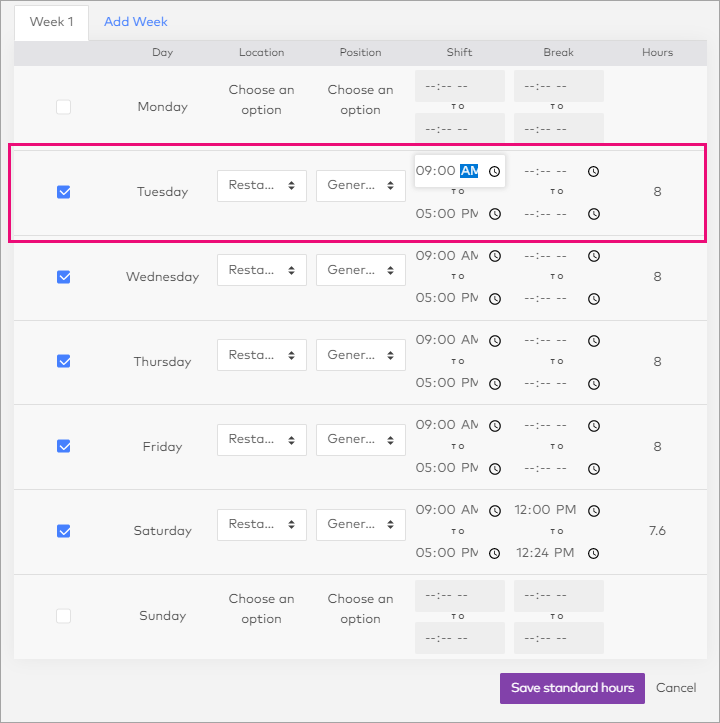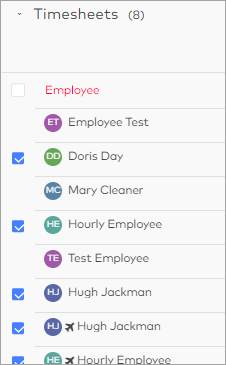Processing public holidays - New Zealand
For MYOB Advanced Workforce Management to determine otherwise working days, you need to check your holiday dates and standard hours are correct, and make sure there are shifts with the correct work types for all paid public holidays (whether the employee works or not). Once that is done you can continue finalising your timesheets as normal.
For information on employers' public holiday obligations, see business.govt.nz – Public holidays.
Setting up public holiday
1. Check your public holiday dates
Before processing public holidays, make sure you've entered them into the Holidays screen, following Checking and adding public holidays for more information.
For this year’s dates, see Employment New Zealand — Public holidays and anniversary dates.
2. Check standard hours have the correct OWDs
MYOB Advanced Workforce Management uses the employee's standard hours to determine whether the calendar or alternate date counts as the public holiday. Employees that do not have standard hours set individually will use the company-wide default standard hours.
Compliance issue – Employees for whom Sunday and Tuesday do not count as OWDs
Where neither the calendar nor alternate dates are otherwise working days (OWDs), the alternate date is counted as the public holiday. Currently, there is an issue in the software causing the holiday date to be incorrectly calculated for employees for whom neither the calendar date or alternate date count as OWDs – for the most part, that's those who don't normally work on either Sundays or Tuesdays.
To workaround this issue, add standard hours for the alternate date for all employees in this situation, regardless of whether they are working, then change them back after the holiday period:
If most of your employees have unpredictable schedules, consider How to update the Default Standard Hours in Management > Settings > Default Standard Hours.
For emloyees who do have standard hours, or who are exceptions to the company defaults (for example employees who are casual or on different work patterns), How do I add Standard Hours to an employee? in Management > Employees > Roster, Time and Attendance.
Example
If your employees mostly work 9 to 5, Monday to Friday, but you have a few who work only Wednesday to Saturday, you would:
Leave your company-wide default hours unchanged to cover the larger group.
Update the standard hours as below, for each employee in the Wednesday to Saturday group.

3. Add shifts for all paid public holidays
For public holidays to be processed correctly, there must be a shift for each employee who will be paid for the day. This includes both employees who are working on the public holiday, as well as those who are being paid for the day off.
Create and publish your roster as you normally would, making sure that everyone that should get paid for a public holiday is either rostered or has taken leave. Note that public holiday timesheet entries will be created automatically where an employee is taking annual leave that starts before and ends after the holiday. Timesheets created from annual leave will already have the correct work types assigned to them.
For more information on adding shifts, see Creating a roster and assigning shifts.
4. Add work types to shifts or timesheets as needed
This section is based on the most typical pay rule and work type setups in MYOB Advanced Workforce Management. The names of the work types and some processes may differ from site to site, depending on your specific needs.
If you're unsure whether this process applies to you, contact your consultant.
Once all your public holiday shifts are added, update the work types for the following situations:
For employees who rostered to work but are not working (i.e. getting paid to take the day off) assign the work type Public Holiday not Worked to their shifts.
For employees that are working where it is not an ordinary working day, assign the work type Public Holiday Worked - Not OWD so that alternative leave does not accrue.
Work types can be assigned individually to shifts and timesheets, or in bulk to timesheets only.
Continuing your pay run
The steps above, along with your system's pay rules, determine the payments and holiday accruals for the public holidays. Once they're done, you're ready to continue your usual pay run processes.
Public holiday worked | OWD | Work type | Payment | Alternative holiday |
|---|---|---|---|---|
Yes | Yes | Not required | Paid time-and-a-half* | Accrued |
Yes | No | Public Holiday Worked - Not OWD | Paid time-and-a-half* | Not accrued |
No | Yes | Public Holiday Not Worked | Paid for the day off | Not accrued |
No | No | Not required | Not paid | Not accrued |
*These payment rates are simplified. See Employment New Zealand – When a Public Holiday Falls on a Weekend for more information about how mondayisation of holidays can affect public holiday payment rates.

